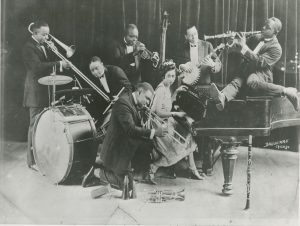After World War I, a new musical form developed by Black musicians in New Orleans erupted in popularity across the country. Jazz flourished in the clubs and theatres of cities touched by the Great Migration, but most famously in Chicago and New York. Iterations of the musical style could be heard everywhere during the 1920s: in vaudeville and movie theatres, in the upscale hotels and clubs the Wormsers visited, and in the clandestine speakeasies and private parties where revelers drank freely during Prohibition. As it spread and transformed, jazz came to signify not only Black culture, or even a musical genre, but the pulse of modern life itself: the rhythms streaming out of clubs and theatres seemed to match the breathless tempo of modern cities, filled with cars, bustling sidewalks, neon lights, and glittering high rises.
LISTEN: The sound of early 1920s jazz.
King Oliver’s Creole Jazz Band, “Dippermouth Blues,” Genett Records (5132), 1923 (c) Olympic Records
